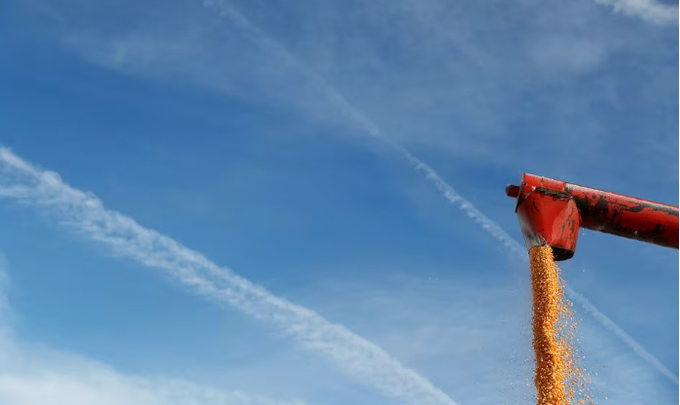June 19, 2025 | 05:12 GMT +7
June 19, 2025 | 05:12 GMT +7
Hotline: 0913.378.918
June 19, 2025 | 05:12 GMT +7
Hotline: 0913.378.918

Corn is loaded into a truck to be transported for ethanol production in Kelley, Iowa, U.S., January 21, 2020.
The market could be setting itself up for a surprise on Friday amid the U.S. Department of Agriculture’s data onslaught since analysts are expecting virtually no changes to last year’s U.S. corn and soybean crop estimates, which are typically the day’s most sought-after numbers.
The trade pegs 2023 U.S. corn production at a record 15.226 billion bushels and soybean output at a four-year low of 4.127 billion bushels. Both are down negligibly from prior projections, but that is not how it tends to shake out on report day.
The U.S. corn crop in January has been smaller than the November projection in seven of the last 10 years, with an average reduction of 1.1%. The soy crop was smaller in six of the last 10 years on an average decline of 1.2%.
The traditional idea that small crops get smaller does not necessarily apply here because the decade’s largest and smallest corn and soy crops alike were subject to January cuts. Average crop increases from November have been relatively smaller with adjustments of less than 0.5%.
U.S. corn and soybean yields rose in November after a rare three-month streak of reductions, but there is no correlation between November increases and the outcome in January.
Also included in Friday’s data dump is quarterly U.S. grain stocks as of Dec. 1. Analysts see Dec. 1 corn stocks at a five-year high for the date, soybeans at a three-year low and wheat a three-year high.
For corn and wheat, four of the past five years have produced bullish Dec. 1 stock numbers while four of the past five have been bearish for soybeans. The bearish corn and wheat instances were in 2021 (for Dec. 1, 2020 stocks) and 2018, respectively, and soybeans’ bullish outcome came last year.
The trade will also be watching for potential demand updates on Friday. As of Jan. 4, U.S. corn export sales for 2023-24 accounted for 57% of USDA’s full-year estimate, near to slightly above average for the date. Soybean sales covered 77% of USDA’s target, a hair behind the typical pace.
USDA has increased 2023-24 U.S. corn exports in the last two updates but has not touched soybean exports since October.
The trade sees U.S. winter wheat plantings for the 2024 harvest down nearly 3% from last year at 35.8 million acres, which would easily be the second-largest area in eight years after last year.
However, there could be an argument for an even larger drop given that U.S. wheat prices by planting last fall were about 25% lower than at the beginning of 2023. That decline is near historical maximums, and most years with steep price declines also preceded some of the larger acreage pullbacks.
Analysts are on a four-year streak of under-guessing winter wheat seedings each January, but they almost exclusively over-estimated acres in the prior two decades. Wheat acres came in a shocking 7% higher than expected last year in the most bearish outcome of this millennium.
Both Chicago and Kansas City wheat futures actually finished higher on January report day last year, aided by a surprisingly small quarterly stocks print. But significant weather concerns were brewing a year ago under ongoing drought, terrible crop conditions and a dry weather-inducing La Nina.
Winter wheat is doing much better this year. For example, the crop in top producer Kansas was rated 43% good-to-excellent at the end of December, up from 32% in late November. That compares with just 19% good-to-excellent in Kansas at the end of 2022.
The current El Nino weather pattern has been welcoming lately for crops in the Southern Plains. As of this week, some 23% of Kansas is drought-free, the largest portion in 18 months.
(Reuters)

(VAN) Extensive licensing requirements raise concerns about intellectual property theft.

(VAN) As of Friday, a salmonella outbreak linked to a California egg producer had sickened at least 79 people. Of the infected people, 21 hospitalizations were reported, U.S. health officials said.

(VAN) With the war ongoing, many Ukrainian farmers and rural farming families face limited access to their land due to mines and lack the financial resources to purchase needed agricultural inputs.

(VAN) Vikas Rambal has quietly built a $5 billion business empire in manufacturing, property and solar, and catapulted onto the Rich List.

(VAN) Available cropland now at less than five percent, according to latest geospatial assessment from FAO and UNOSAT.

(VAN) Alt Carbon has raised $12 million in a seed round as it plans to scale its carbon dioxide removal work in the South Asian nation.

(VAN) Attempts to bring down the price of the Japanese staple have had little effect amid a cost-of-living crisis.